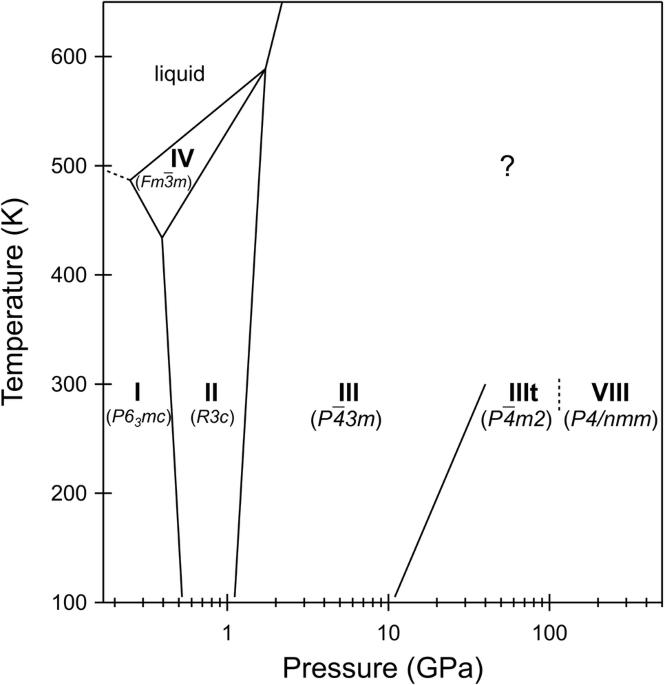Structural phase transition in NH₄F under extreme pressure conditions
IF 5.9
2区 化学
Q1 CHEMISTRY, MULTIDISCIPLINARY
引用次数: 0
Abstract
Ammonium fluoride (NH₄F) exhibits a variety of crystalline phases depending on temperature and pressure. By employing Raman spectroscopy and synchrotron X-ray diffraction beyond megabar pressures (up to 140 GPa), we have here observed a novel dense solid phase of NH₄F, characterised by the tetragonal P4/nmm structure also observed in other ammonium halides under less extreme pressure conditions, typically a few GPa. Using detailed ab-initio calculations and reevaluating earlier theoretical models pertaining to other ammonium halides, we examine the microscopic mechanisms underlying the transition from the low-pressure cubic phase (P-43m) to the newly identified high-pressure tetragonal phase (P4/nmm). Notably, NH₄F exhibits distinctive properties compared to its counterparts, resulting in a significantly broader pressure range over which this transition unfolds, facilitating the identification of its various stages. Our analysis points to a synergistic interplay driving the transition to the P4/nmm phase, which we name phase VIII. At intermediate pressures (around 40 GPa), a displacive transition of fluorine ions initiates a tetragonal distortion of the cubic phase. Subsequently, at higher pressures (around 115 GPa), every second ammonium ion undergoes a rotational shift, adopting an anti-tetrahedral arrangement. This coupled effect orchestrates the transition process, leading to the formation of the tetragonal phase. Solid ammonium fluoride has fascinating structural similarities with water ice, despite its ionic character. Here, the authors investigate NH4F at room temperature and high pressure, and report a new tetragonal phase formed through displacive transition of fluorine ions and subsequent rotation of ammonium ions in ‘antiferromagnetic’ units at ~115 GPa, which is unlike any form of ice.

极压条件下 NH₄F 的结构相变
氟化铵(NH₄F)根据温度和压力的不同表现出多种结晶相。通过采用拉曼光谱和同步辐射 X 射线衍射技术,我们在兆帕压力(高达 140 GPa)以上观察到了 NH₄F 的一种新型致密固相,其特征为四方 P4/nmm 结构,在压力较低的极端条件下(通常为几 GPa),我们在其他卤化铵中也观察到了这种结构。通过详细的 ab-initio 计算和重新评估与其他卤化铵有关的早期理论模型,我们研究了从低压立方相(P-43m)向新发现的高压四方相(P4/nmm)转变的微观机制。值得注意的是,NH₄F 与其对应物相比表现出与众不同的特性,从而使这一转变的压力范围大大拓宽,有利于确定其各个阶段。我们的分析表明,在向 P4/nmm 相转变的过程中,存在着协同作用,我们将其命名为第八阶段。在中间压力下(约 40 GPa),氟离子的置换转变引发了立方相的四方畸变。随后,在较高压力下(约 115 GPa),每第二个铵离子都会发生旋转转变,采用反四面体排列。这种耦合效应协调了过渡过程,导致了四方相的形成。固体氟化铵尽管具有离子特性,但在结构上却与水冰有着惊人的相似之处。作者在本文中研究了室温和高压下的 NH4F,并报告了在 ~115 GPa 下通过氟离子的置换转变和随后铵离子在 "反铁磁 "单元中的旋转形成的新四方相,这与任何形式的冰都不同。
本文章由计算机程序翻译,如有差异,请以英文原文为准。
求助全文
约1分钟内获得全文
求助全文
来源期刊

Communications Chemistry
Chemistry-General Chemistry
CiteScore
7.70
自引率
1.70%
发文量
146
审稿时长
13 weeks
期刊介绍:
Communications Chemistry is an open access journal from Nature Research publishing high-quality research, reviews and commentary in all areas of the chemical sciences. Research papers published by the journal represent significant advances bringing new chemical insight to a specialized area of research. We also aim to provide a community forum for issues of importance to all chemists, regardless of sub-discipline.
 求助内容:
求助内容: 应助结果提醒方式:
应助结果提醒方式:


